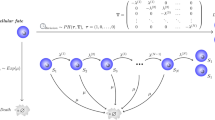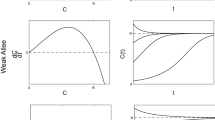Abstract
A survey of three types of cell population models is presented in this paper. The main issue in all the surveyed words is whether or not there exists astable type distribution (s.t.d.). In the last few years, many efforts were directed towards describing the most general models which still exhibits.t.d. Progress made in the case ofsize density models are discussed. A slightly extended version of atime continous daughter cell model, studied in Arino et al. (1991), is presented. Recently, some authors have undertaken the task of comparing models of various origins and types. Such works are alluded to in a discussion.
Similar content being viewed by others
References
Arino, O. and M. Kimmel (1987). Asymptotic analysis of a cell cycle model based on unequal division. SIAM J. Appl. Math. 47: 128–145.
Arino, O. and M. Kimmel (1989). Asymptotic behavior of a nonlinear functional-integral equation of cell kinetics with unequal division. Journal of Math. Biology 27: 341–354.
Arino, O. and M. Kimmel (1991). Asymptotic behavior of nonlinear semigroup describing a model of selective cell growth regulation. Journal of Math. Biology 29: 289–314.
Arino, O. and M. Kimmel (1993). Comparison of approaches to modeling of cell population dynamics. SIAM J. Appl. Math. 53: to appear.
Arino, O., M. Kimmel and M. Zerner (1991). Analysis of a cell population model with unequal division and random transition. In: A. Arino, D. Axelrod & M. Kimmel. eds., Proc. of the 2nd International Conf. M.P.D., p. 3–12, New York, Marcel Dekker.
Bell, G.I. and E.C. Anderson (1967). Cell growth and division. I. A mathematical model with applications to cell volume distributions in mammalian suspension cultures. Biophysical Journal 7: 329–351.
Clement, Ph., H.J.A.M. Heijmans, S. Angenent, C.J. van Duijn and B. de Pagter (1987). One-Parameter Semigroups, Amsterdam, North-Holland.
Darzynkiewicz, Z., D.P. Evenson, L. Staiano-Coici T.K. Sharpless and M.R. Melamed (1982). Correlation between cell cycle duration and RNA content. Journal of Cell Physiology 100: 425–438.
Diekmann, O. (1982). Lecture Notes in Biomathematics 54, p. 90–96. Berlin, Springer Verlag.
Diekmann, O., H.J.A.M. Heijmans and H.R. Thieme (1984). on the stability of the cell size distribution. Journal of Math. Biology 19: 227–248.
Diekmann, O., H.A., Lauwerier, T.A. Aldenberg and J.A.J. Metz (1983). Growth, fission and the stable size distribution. Journal of Math. Biol. 18: 135–148.
Feller, W. (1941). On the integral equation of renewal theory. Annals of Math. Statistics 12: 243–267.
Greiner, G. (1987). Perturbing the boundary conditions of a generator. Houston Journal of Maths 13: 213–229.
Greiner, G. and R. Nagel (1988). Growth of cell population via one-parameter semigroups of positive operators. Math. Appl. to Science: 79–105.
Gurtin, M.E. and R.M. MacCamy (1974). Nonlinear age-dependent population dynamics. Archive for Rational Mechanics and Analysis 54: 281–300.
Gyllenberg, M. (1982). Nonlinear age-dependent population dynamics in continously propagated bacterial cultures. Math. Bioscience 62: 45–74.
Gyllenberg, M. and G. Webb (1987). Age-size structure in population with quiescence. Math. Bioscience 86: 67–95.
Gyllenberg, M. and G. Webb (1989). Quiescence as an explanation of gompertzian tumor growth. Growth, Development and Aging 53: 25–33.
Gyllenberg, M. and G. Webb (1990). A nonlinear structured population model of tumor growth with quiescence. Journal of Math. Biology 28: 671–694.
Gyllenberg, M. and G. Webb (1991). Quiescence in structured population dynamics. Lecture Notes in Pure and Applied Mathematics 131: 45–62. Dekker.
Heijmans, H.J.A.M. (1984). On the stable size distribution of populations reproducing by fission into two unequal parts. Math. Bioscience 72: 19–50.
Heijmans, H.J.A.M. (1986). Structured populations, linear semigroups and positivity. Math. Z. 191: 599–617.
John, P.C.L. (1981). The Cell Cycle. London, Cambridge University Press.
Kimmel, M. and O. Arino (1991). Cell cycle kinetics with supramitotic control, two cell cycles, and unequal division: a model of transformed embryonic cell. Math. Bioscience 105: 47–79.
Kimmel, M., Z. Darzynkiewicz, O. Arino and F. Traganos (1984). Analysis of a cell cycle model based on unequal division of metabolic constituents, to daughter cells during cytokinesis. J. Theor. Biol. 110: 637–664.
McKendrick, A.C. (1926). Applications of mathematics to medical problems. Proc. of the Edinburgh Math. Society 44: 98–130.
Lasota, A. and M.C. Mackey (1984). Globally asymptotic properties of proliferating cell populations. Journal of Math. Biology 19: 43–62.
Lasota, A. and M.C. Mackey (1985). Probabilistic Properties of Deterministic Systems. Cambridge, Cambridge University Press.
Lasota, A. and M.C. Mackey (to appear). Statistical stability of strongly perturbed dynamical systems: In: O. Arino, D. Axelrod & M. Kimmel, eds., Proc. of the 3rd International Conference on M.P.D., Pau, June 1992.
Metz, J.A.J. and O. Diekmann (eds.)(1986). Dynamics of Physiologically Structured Populations. Lecture Notes in Biomathematics 86. Springer Verlag.
Mitchison, J.M. (1971). The Biology of the Cell Cycle. London, Cambridge University Press.
Nagel, R. (ed)(1986). One-Parameter Semigroups of Positive Operators. Lecture Notes in Mathematics 1184. Springer Verlag.
Prüss, J. (1981). Equilibrium solutions of age-specific population dynamics of several species. Journal of Math. Biology 11: 65–84.
Prüss, J. (1984). On the spectrum of c0-semigroups. Transactions of the A.M.S. 284: 847–857.
Rossa, B. (1991). Asynchronous exponential growth of linear C0-semigroups and a new tumor cell population model. PhD Thesis, Vanderbilt University.
Rossa, B. (to appear). Asynchronous exponential growth in a size structured cell population with quiescent compartment. In: O. Arino, D. Axelrod & M. Kimmel, eds., Proc. of the 3rd International Conf. on M.P.D., Pau, June 1992.
Sennerstam, R., J. O. Strömberg (to appear). Cell cycle progression: computer simulation of uncoupled subcycles of DNA replication and cell growth. In: O. Arino, D. Axelrod & M. Kimmel, eds., Proc. of the 3rd International Conf. on M.P.D., Pau, June 1992.
Sharpe, F.R. and A. Lotka (1911). A problem in age-distribution. Philosophical Magazine, Ser. 621: 435–438.
Smith, J.A. and L. Martin (1973). Do cells cycle? Proc. of the National Academy of Sciences USA 70: 1263–1267.
Tyson, J. and K. Hannsgen (1985). Global asymptotic stability of the size distribution in probabilistic model of the cell cycle. Journal of Math. Biology 22: 61–68.
Tyson, J. and K. Hannsgen (1986). Cell growth and division: a deterministic/probabilist model of the cell cycle. Journal of Math. Biology 23: 231–246.
Webb, G. (1983). A semigroup proof of the Sharpe-Lotka theorem. Lecture Notes in Mathematics 1076: 254–268. Springer Verlag.
Webb, G. (1985). Theory of Nonlinear Age-Dependent Population Dynamics. Monographs and Textbooks in Pure and Appl. Math. Series, 89. Dekker.
Webb, G. (1987a). Random transitions, size control, and inheritance in cell population dynamics. Math. Bioscience 85: 71–91.
Webb, G. (1987b). An operator-theoretic formulation of asynchronous exponential growth. Transactions of the A.M.S. 303: 751–763.
Webb, G. and A. Grabosch (1987). Asynchronous exponential growth in transition probability models of the cell cycle. SIAM J. Math. Anal. 18: 897–908.
Author information
Authors and Affiliations
Rights and permissions
About this article
Cite this article
Arino, O. A survey of structured cell population dynamics. Acta Biotheor 43, 3–25 (1995). https://doi.org/10.1007/BF00709430
Issue Date:
DOI: https://doi.org/10.1007/BF00709430




